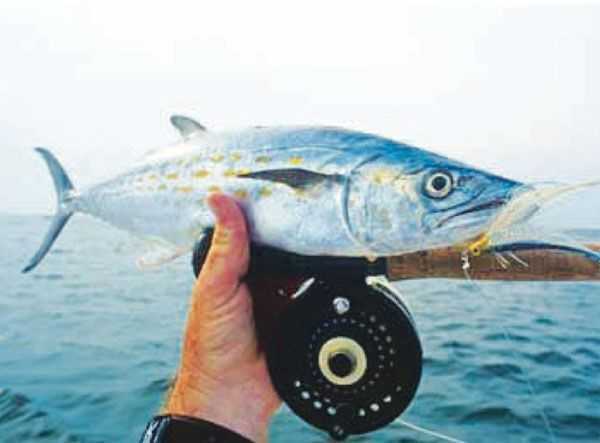
Many people are astonished when they hear someone mention fly fishing in saltwater. They shouldn’t be because fly fishing our oceans and sounds is a growing sport. For many years, saltwater anglers have tackled a variety of saltwater species, matching the size of the tackle to the size of the fish being pursued. Probably the majority of the saltwater fish caught are flounder, drum, trout, Spanish mackerel, bluefish and similar species…in a size that is easily handled on light to medium weight fly fishing tackle. All of these fish will readily take a fly.
The typical freshwater bass fly rod such as a 7-9 wt. outfit is a good choice for many of the commonly caught saltwater fish. The key, like in so many fishing situations, is to select a fly that resembles what saltwater fish eat, typically minnows, crabs, and shrimp. There are many flies that are designed to do just that in the 1.5 – 3.5 inch size. Saltwater species are known to be hard fighting and often have plenty of room to run. This means your fly reel should have plenty of backing, that being the braided Dacron line that goes on the reel first, before attaching fly line. About 50 yards of backing is probably sufficient in our sounds, but a hundred yards is probably better. If you are fishing offshore or near shore, targeting trout or drum, you may want a reel with a capacity of 150-200 yards of backing. The potential exists to hook a much larger fish (false albacore, king mackerel, cobia etc.) and it’s a good idea to be
prepared for longer runs.
The other significant difference is that many saltwater fish have some significant teeth. That often means you need to use a heavier leader than in freshwater. For toothy prey like blues and Spanish, expect to use a 20-30lb piece of mono, or wire, on the end of a leader, just to keep the flies from being bitten off.
Fly fishing in the ocean or sounds is much like fishing a large lake. You cast to likely fish holding areas like piers, rock jetties, drop-offs, oyster rocks and places where tide is flowing in or out of shallow areas. If you are accustomed to fishing the salt with popping corks, jigs and curly tails, and lures, the technique with a fly rod is much the same. Cast out, allow the fly to sink, then begin stripping the line in by hand rather than turning the handle on a spinning reel. In other situations, target obvious areas where albies, Spanish and blues are attacking baitfish near the surface.
If you want to get started fly fishing at the coast, there are some guidelines. Most often recommended is an 8 or 9 wt. outfit. Any good fly shop can steer you in the right direction. The rod, reel and line do not have to be expensive, especially if you are targeting typical saltwater fish like drum, flounder and trout. You could get a serviceable combo in the $145 range. If you choose to buy individual components with a better warranty, expect to spend $250-300 minimum. To get flies down in deeper water or in the surf, you may want a line with a sinking head or a full sinking line. In many cases, however, a standard floating fly line will be fine.
Like many aspects of fly fishing, the better you can cast the more fish you will catch. Consequently, it is always a good idea to get some good casting instruction, especially regarding increasing your distance. For a lot of fly fishermen, the casting technique that seems adequate for bream in a farm pond, doesn’t measure up at the coast where more distance is needed and wind is often a factor. Better casting means more fun.
Fly fishing in saltwater will open up a new fishing adventure at the coast. It’s easy to do with a few simple adaptations to a different environment. Give it a shot…it will add some variety to your next vacation.
[easy-social-share]